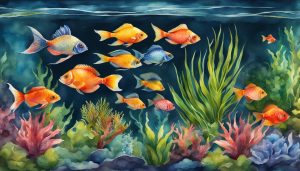Hey there, fellow aquarium enthusiasts! Today, I want to share with you a comprehensive tutorial on how to clean aquarium gravel. Having clean gravel in your tank is essential for maintaining a healthy and thriving aquatic environment. By following this step-by-step guide, you’ll be able to keep your aquarium gravel sparkling clean and your fish happy and healthy.
Key Takeaways:
- Cleaning aquarium gravel is crucial for maintaining a healthy tank environment
- Regular gravel cleaning helps remove debris, waste, and harmful toxins
- Use a gravel vacuum to efficiently clean the gravel without removing it from the tank
- Remember to clean the gravel before using it for the first time in your aquarium
- Make gravel cleaning a part of your regular maintenance routine for optimal results
Why Cleaning Aquarium Gravel is Important for a Healthy Tank
Keeping your aquarium gravel clean is a crucial aspect of maintaining a healthy tank environment for your fish. Neglecting to clean the gravel regularly can have serious consequences on the overall well-being of your aquatic pets.
Let’s explore the benefits of cleaning aquarium gravel and understand the importance of this task in ensuring optimal fish health.
The Impact of Dirty Gravel on Fish Health
Dirty gravel accumulates waste, uneaten food, and other debris over time. This build-up can lead to various problems that directly affect the health of your fish.
- Poor Water Quality: When debris decomposes in the gravel, it releases harmful substances into the water, such as ammonia and nitrites. These chemicals can cause stress and illness in fish.
- Inadequate Oxygen Levels: The decomposition process consumes oxygen, leading to a decrease in oxygen levels within the aquarium. This can negatively impact the respiration of your fish and other aquatic organisms.
- Bacterial Growth: Dirty gravel provides an ideal breeding ground for harmful bacteria, including those that cause diseases. Fish living in a tank with unclean gravel are more susceptible to bacterial infections.
The Benefits of Cleaning Aquarium Gravel
Cleaning aquarium gravel on a regular basis offers several key benefits:
- Improves Water Quality: Removing debris and waste from the gravel helps maintain excellent water quality, reducing the risk of ammonia spikes and other water chemistry imbalances.
- Enhances Oxygen Levels: By eliminating decomposing matter, cleaner gravel contributes to healthier oxygen levels, creating a more suitable environment for your fish to thrive.
- Reduces Disease Risks: Regular gravel cleaning significantly reduces the risk of bacterial infections and other diseases, promoting better overall fish health.
Additionally, clean aquarium gravel helps to enhance the visual appeal of your tank, providing a cleaner and more aesthetically pleasing aquatic environment.
Regularly cleaning your aquarium gravel is essential for maintaining the overall well-being of your fish. By preventing water quality issues, reducing disease risks, and enhancing oxygen levels, you provide your beloved aquatic pets with a healthier and more enjoyable habitat.
Continue reading to learn tips and best practices for efficient aquarium gravel cleaning in the next section.
| Impact of Dirty Gravel on Fish Health | Benefits of Cleaning Aquarium Gravel |
|---|---|
| Poor water quality | Improves water quality |
| Inadequate oxygen levels | Enhances oxygen levels |
| Bacterial growth | Reduces disease risks |
Tips and Best Practices for Efficient Aquarium Gravel Cleaning

Keeping your aquarium gravel clean is essential for maintaining a healthy environment for your fish. Here are some tips and best practices to make your gravel cleaning routine more efficient:
- Use a gravel vacuum: A gravel vacuum is a useful tool for removing debris and waste from your aquarium gravel. It works by siphoning out the dirt while leaving the clean gravel behind.
- Clean the gravel regularly: Regular maintenance is key to preventing the buildup of waste and harmful substances in your aquarium. Aim to clean your gravel once a week or every other week, depending on the size of your tank and the number of fish.
- Start from one side: When vacuuming the gravel, start from one side of the tank and work your way across. This allows you to cover the entire surface area and ensures thorough cleaning.
- Be gentle: Avoid stirring up the gravel too vigorously, as it can disturb the beneficial bacteria that help maintain the balance in your aquarium. Gently slide the vacuum through the gravel to remove debris without causing disruption.
- Keep an eye on the water level: As you clean the gravel, the water level in your tank may drop. Be sure to monitor it closely and top up with dechlorinated water if necessary.
- Consider using a pre-filter: If you have a lot of debris in your aquarium, using a pre-filter on your gravel vacuum can help prevent clogging and extend the life of your equipment.
By following these efficient aquarium gravel cleaning methods and best practices, you can ensure a clean and healthy environment for your fish to thrive in.
Testimonial
“I used to struggle with keeping my aquarium gravel clean until I discovered these tips. Now my tank looks pristine, and my fish are much happier!”
– Jane Smith, Aquarium Enthusiast
| Benefits of Efficient Gravel Cleaning | Best Practices for Cleaning Gravel |
|---|---|
| 1. Removes waste and debris | 1. Use a gravel vacuum |
| 2. Reduces harmful substances | 2. Clean the gravel regularly |
| 3. Maintains water quality | 3. Start from one side |
| 4. Prevents algae growth | 4. Be gentle |
| 5. Promotes fish health | 5. Keep an eye on the water level |
| 6. Consider using a pre-filter |
Cleaning Gravel Before Initial Use and Troubleshooting Tips
Before introducing gravel into your aquarium for the first time, it is crucial to ensure it is thoroughly cleaned. Cleaning the gravel helps remove any dirt, dust, debris, or potential harmful residues that may be present. Here are the steps you should follow:
1. Rinse the gravel: Place the gravel in a bucket and rinse it under running water. Use your hands to agitate the gravel, allowing any loose particles to wash away. Repeat this process until the water runs clear, indicating that the gravel is clean.
2. Soak the gravel: Fill the bucket with fresh water and soak the gravel for a few hours. This helps further remove any residual dirt or chemicals that may be lingering on the surface of the gravel.
3. Scrub the gravel: If you notice stubborn stains or residue, you can use a soft brush or sponge to gently scrub the gravel. Be cautious not to apply too much pressure, as this can damage the gravel or disrupt the beneficial bacteria present in your aquarium.
Troubleshooting Common Gravel Cleaning Issues:
1. Cloudy water after cleaning: If you experience cloudy water after cleaning the gravel, it may be due to fine particles that were stirred up during the process. To resolve this issue, perform a partial water change and use a fine-mesh net or filter media to remove any suspended particles.
2. Gravel clogging the filter: If your filter gets clogged with gravel, it is likely because the gravel particles are too small. Consider using a filter media bag or reducing the size of the gravel to prevent it from entering the filter. Regularly checking and cleaning the filter can also help prevent clogs.
3. Loss of beneficial bacteria: Cleaning the gravel can disrupt the balance of beneficial bacteria in your aquarium. To mitigate this, avoid cleaning the entire gravel bed at once, focusing on smaller sections during routine maintenance. It’s also advisable to use a bacterial additive to help replenish the beneficial bacteria.
By following these steps and troubleshooting tips, you can ensure your aquarium gravel is clean, safe, and ready for use. A clean gravel bed promotes a healthy environment for your fish and aquatic plants, contributing to the overall well-being of your aquarium.








